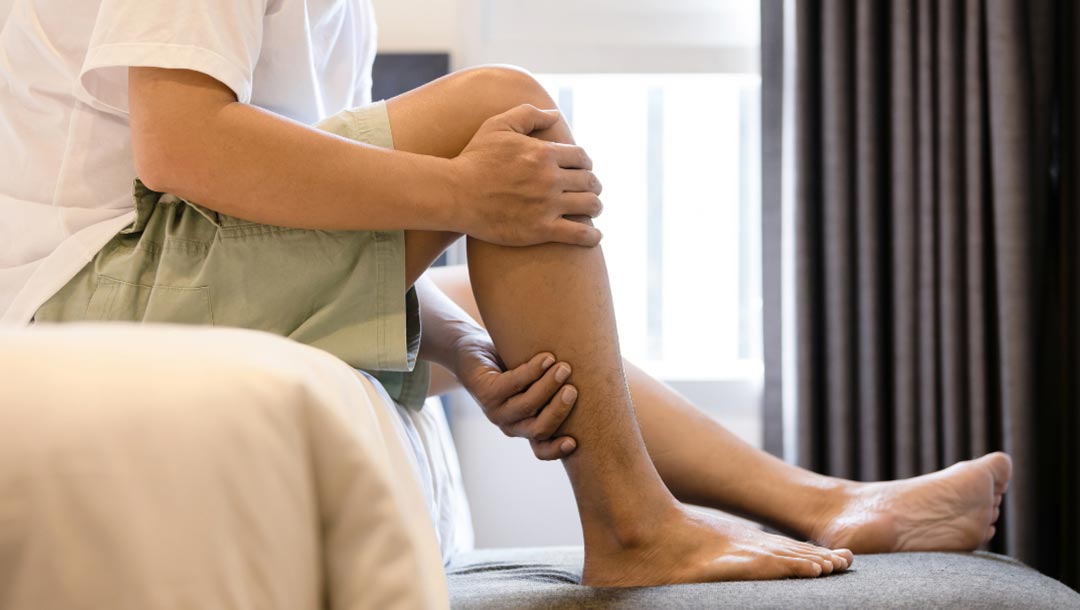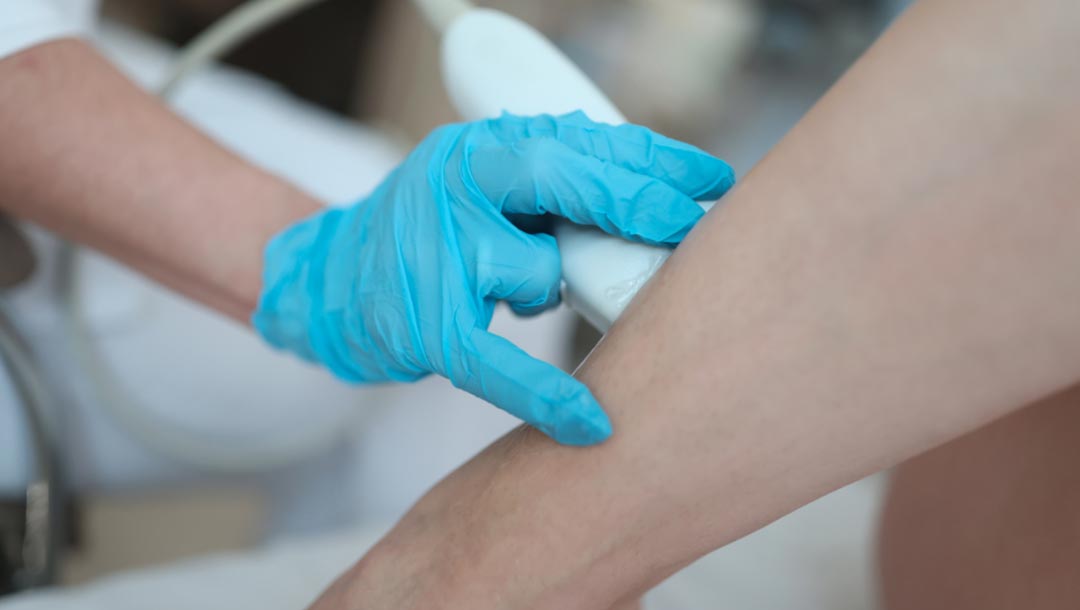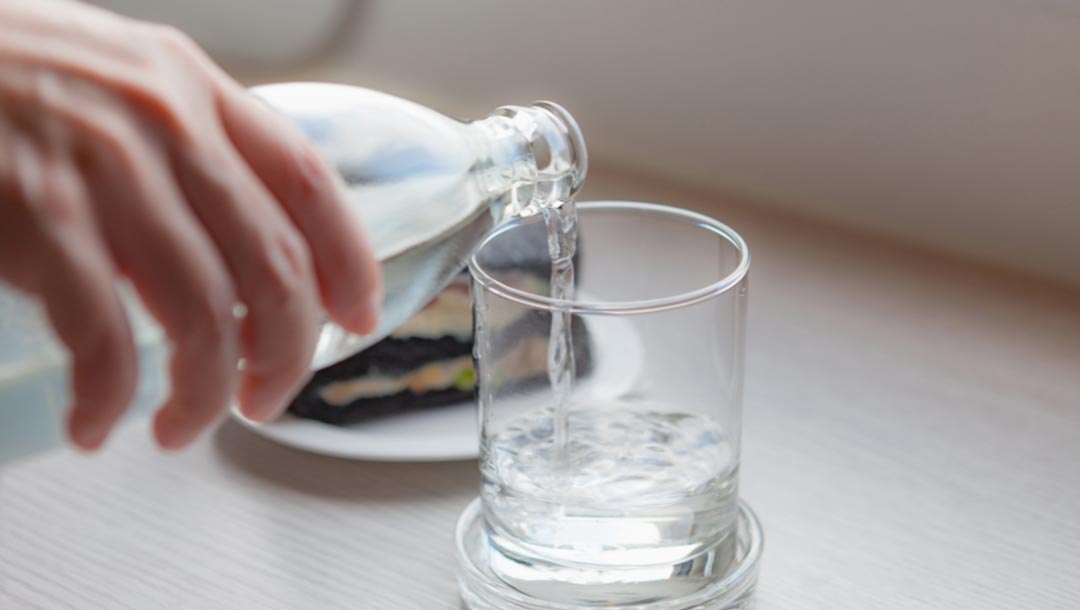What is superficial thrombophlebitis?
Superficial thrombophlebitis is a condition where a vein near the surface of the skin becomes inflamed due to a blood clot. It most often affects the legs but can occur in other parts of the body as well. The affected vein may feel hard or tender, and the area around it may appear red, swollen, or warm.
Unlike deep vein thrombosis (DVT), which affects deeper veins and can lead to serious complications, superficial thrombophlebitis usually resolves on its own and is rarely dangerous. However, it can be uncomfortable and may indicate underlying issues with the veins, such as varicose veins or venous insufficiency.

How superficial thrombophlebitis develops
This condition occurs when a small blood clot forms in a superficial vein and causes irritation. The clot triggers inflammation, which leads to pain, redness, and swelling in the surrounding tissue. It’s more likely to develop in veins that are already weakened or stretched, such as varicose veins.
Things like injury to the vein, reduced blood flow, or certain medical conditions can contribute. The clot in superficial thrombophlebitis usually stays in place and doesn’t travel to the lungs, but if it’s near a junction with a deeper vein, careful monitoring is important.
Who is affected?
Superficial thrombophlebitis can affect anyone, but it’s more common in:
- People with varicose veins
- Those who have had recent injections or intravenous catheters
- People recovering from surgery or injury, or those with underlying malignancy
- Individuals who are pregnant or have recently given birth
- People with certain blood-clotting disorders
- Older adults, particularly over the age of 60
Understanding your personal risk can help you stay alert to early signs and seek timely treatment.
Signs and symptoms of superficial thrombophlebitis
Symptoms of superficial thrombophlebitis tend to appear suddenly and affect a small area of the body, usually along the course of a vein in the leg. The symptoms can be uncomfortable but are usually confined to a localised area and don’t cause widespread illness.
Common signs and symptoms
Common signs include:
- Redness along a vein: The skin over the affected vein may appear red or inflamed.
- Swelling and tenderness: The area may be puffy or feel sore to touch.
- A firm, cord-like feeling under the skin: This is caused by the inflamed vein, which may feel hard or rope-like.
- Localised warmth or discomfort: The skin in the affected area may feel warmer than surrounding tissue.
Sometimes, a small lump may form along the vein, and you may feel a burning sensation. These symptoms usually appear on one leg and are more noticeable when standing or walking. Although rare, a fever or spreading redness could indicate a more serious issue like infection and should be assessed by a doctor.
The affected vein often feels sore to the touch and may become more painful when standing or walking. Symptoms are usually limited to the surface and don’t cause general illness or fever unless infection is present.
When symptoms may worsen
Pain and swelling tend to get worse:
- After long periods of standing or sitting, especially without movement
- When walking for extended periods or doing physical activity
- If the affected area is knocked, compressed, or exposed to pressure (e.g. tight clothing)
- In hot weather, when veins tend to dilate and inflammation may feel stronger
You may also notice that symptoms are more intense at the end of the day, particularly if you’ve been on your feet or inactive for several hours. Some people experience a flare in discomfort after long journeys or flights due to reduced circulation.
These symptoms usually settle within a few weeks with appropriate care. However, if they spread or worsen rapidly, it's important to seek medical attention, as this could indicate a more serious clot or infection.
Causes and risk factors
Common causes
Superficial thrombophlebitis occurs when something triggers inflammation and clotting in a superficial vein. This usually involves some form of irritation or injury to the vein wall, which activates the body’s clotting response.
Common causes include:
- Varicose veins: These are enlarged, twisted veins that often have faulty valves. They are more prone to clotting and inflammation due to poor blood flow.
- Injury to the vein: This might result from medical procedures (like injections or cannula placement), surgery, or even minor trauma.
- Prolonged immobility: Long periods of sitting or bed rest reduce circulation, making clots more likely to form.
- Recent childbirth: Pregnancy increases blood volume and pressure in the veins, which can lead to clot formation. The postpartum period is particularly associated with increased clotting risk.
- Infection or inflammation: An infection in or near the vein can cause it to become inflamed, increasing the chance of clotting.
- Intravenous drug use: Repeated vein puncture can damage vein walls and lead to inflammation and thrombosis.
Risk factors you should know
You're more likely to develop superficial thrombophlebitis if you have:
- A history of varicose veins or chronic venous insufficiency
- Recent vein procedures such as a cannula, injection, or catheter
- Pregnancy or recent childbirth, which increase vein pressure and affect hormones
- A sedentary lifestyle or are overweight, both of which reduce circulation
- Use of hormone-based medications like the contraceptive pill or HRT
- A family or personal history of blood clots or clotting disorders or underlying conditions that make the blood more sticky than usual, such as clotting disorders or cancer
- Age over 60, when veins naturally weaken and circulation can slow
How superficial thrombophlebitis is diagnosed
Clinical examination
To diagnose superficial thrombophlebitis, your doctor will examine the affected area and ask about your symptoms, such as pain, redness, and swelling. They may gently press on the area to see how tender it is and feel for a hardened or rope-like vein. A detailed medical history will also help identify any risk factors such as varicose veins, immobility, or any recent trauma to the veins.
Diagnostic tests
If the affected vein is close to a deep vein or your symptoms are more widespread than expected, your doctor may recommend an ultrasound scan. This helps confirm whether the clot is at risk of extending into a deep vein, which could mean a more serious condition like deep vein thrombosis (DVT).
An ultrasound is a safe, painless scan that uses sound waves to create images of your veins and measure blood flow. It’s commonly used to distinguish superficial thrombophlebitis from deeper vein issues.
In some cases, especially if infection is suspected or symptoms are more severe, your doctor might also order a blood test to look for signs of inflammation or other underlying problems. These checks help confirm the diagnosis and ensure there are no additional complications.

Treatment options for superficial thrombophlebitis
There is no cure for superficial thrombophlebitis, but treatment can ease symptoms and improve quality of life. Most treatments focus on improving circulation, reducing inflammation, and preventing complications.
Conservative management
Most cases of superficial thrombophlebitis are mild and can be managed at home with self-care and symptom relief. Common treatments include:
- Pain relief: Non-steroidal anti-inflammatory drugs (NSAIDs) like ibuprofen can reduce pain, redness, and swelling. Paracetamol may also be used if NSAIDs aren't suitable.
- Warm compresses: Applying a warm cloth to the affected area a few times a day can help ease discomfort and improve blood flow.
- Leg elevation: Keeping the leg raised when sitting or lying down can reduce swelling and pressure in the veins.
- Staying mobile: Gentle, regular walking encourages blood flow and prevents further clotting.
- Compression stockings: These support the veins and may reduce swelling and the risk of future clots, especially in people with varicose veins.
Conservative treatment is usually effective, and symptoms tend to improve within a couple of weeks. Your GP may monitor your progress to ensure the condition is resolving as expected.
When additional treatment is needed
In certain cases, your doctor may recommend further treatment:
- Anticoagulants (blood thinners): These may be prescribed if the clot is very long (typically more than 5 cm) or close to a junction with a deep vein, where they may be a risk of progression to deep vein thrombosis. Anticoagulants help prevent the clot from growing or moving but only necessary in certain cases.
- Antibiotics: If the area becomes infected, signs include fever, pus, or spreading redness, antibiotics may be required to treat the infection.
- Referral to a specialist: If symptoms don’t improve with conservative treatment, or if there’s a history of recurrent thrombophlebitis, you may be referred to a vascular specialist for further investigation and management.
These treatments are generally safe and used on a case-by-case basis depending on your symptoms and risk factors.
What to expect during and after treatment
During treatment
Treatment of superficial thrombophlebitis usually starts at home if the clot is small and away from deeper veins. You may be advised to take pain relief, use warm compresses, wear compression stockings, and keep your leg elevated. Staying mobile is also important. Follow-up checks may be arranged if symptoms don't improve or if there’s concern about complications.
Aftercare and recovery
Most people recover within a few weeks. Pain, redness, and swelling usually fade, though the vein might stay firm or discoloured for a while. To support healing:
- Keep moving with light activity
- Elevate your leg when resting
- Wear compression stockings if advised
- Avoid pressure or tight clothing over the area
Contact your doctor if symptoms return, worsen, or if you notice spreading redness or fever.
Follow-up and long-term care
After initial recovery, it's important to continue monitoring your vein health. Superficial thrombophlebitis may return, especially if underlying vein problems like varicose veins remain untreated. Your healthcare provider may recommend routine check-ins or imaging if you’ve had repeated episodes.
- Monitoring for recurrence: Be alert for new lumps, redness, or tenderness along veins.
- Managing varicose veins: Treating these, whether with compression, sclerotherapy, or surgery, can reduce your risk of future clots.
- Lifestyle advice: Staying physically active, avoiding long periods of sitting or standing still, maintaining a healthy weight, and stopping smoking can all support long-term vein health.
- Compression use: You may be advised to wear compression stockings for longer-term support, especially if you remain at higher risk.
Working with your GP or a vascular specialist can help create a care plan tailored to your needs, reducing the risk of recurrence and improving overall vein health.
Preventing superficial thrombophlebitis
There’s no guaranteed way to prevent superficial thrombophlebitis, but these steps can help reduce your risk:
- Stay active and avoid sitting for long periods
- Maintain a healthy weight
- Treat varicose veins early if advised
- Use compression if recommended after surgery or during travel
- Stay hydrated and avoid smoking
If you’ve had superficial thrombophlebitis before, being proactive about your vein health can help prevent future episodes.

When to seek medical advice
Signs you shouldn't ignore
Speak to your GP if you:
- Notice a painful, red vein under the skin
- Have a firm or tender lump along a vein
- Experience symptoms that spread or worsen quickly
- Develop fever or signs of infection
Urgent care is needed if you experience:
- Chest pain
- Sudden shortness of breath
- Swelling in the whole leg
These could be signs of a deep vein thrombosis or pulmonary embolism and require immediate attention.


